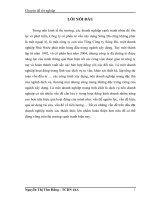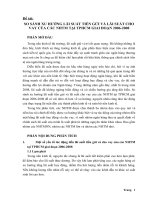Metamorphism student copy
Bạn đang xem bản rút gọn của tài liệu. Xem và tải ngay bản đầy đủ của tài liệu tại đây (3.76 MB, 44 trang )
Metamorphism
Metamorphic Rocks & the Rock Cycle
Types of Metamorphism
Patterns of
Metamorphic
Grade
Mineral Assemblages in
Metamorphic Rocks
METAMORPHIC ROCKS
Metamorphic
Textures
Index Minerals
Phase Diagrams
Factors affecting type
of metamorphic rock
Metamorphic Rocks
By the end of this lesson you will be able to:
• Classify metamorphic rocks into two groups.
• Explain the concept of metamorphic grade.
• Describe the causes of the different types of metamorphism.
• Explain how metamorphic reactions occur during metamorphism.
Metamorphic Rocks
List down as many metamorphic rocks as you can remember:
• spotted rock
• hornfels
• marble
• metaquartzite
• slate
• phyllite
• schist
• gneiss
Metamorphic Rocks
Which ones are foliated and which ones are unfoliated?
• spotted rock
• hornfels
• marble
unfoliated
• metaquartzite
• slate
• phyllite
• schist
• gneiss
foliated
Metamorphic Rocks
Which can be formed due to contact metamorphism & which
can be formed due to regional metamorphism?
• spotted rock
• hornfels
• marble
unfoliated
Contact
metamorphism
• metaquartzite
• slate
• phyllite
• schist
foliated
Regional
metamorphism
• gneiss
• mylonite/fault breccia
Dynamic
metamorphism
Metamorphic Processes
• Mineral alignment
• Recrystallisation
• New minerals formed from metamorphic reactions
Metamorphic Reactions
Low temperature minerals
Change in stability
High temperature minerals
PROGRADE REACTION
reactants
temp by 550 °C
products
(increase in metamorphic grade)
muscovite + quartz = feldspar + sillimanite + water vapour
products
temp by 550 °C
reactants
(decrease in metamorphic grade)
RETROGRADE REACTION
Low temperature minerals
Change in stability
High temperature minerals
Metamorphic Reactions
Low temperature minerals
Change in stability
High temperature minerals
PROGRADE REACTION
reactants
temp by 550 °C
products
Escapes from
rock
(increase in metamorphic grade)
muscovite + quartz = feldspar + sillimanite + water vapour
Metamorphic
mineral
Phase Diagrams
Kyanite stability field.
Phase boundary
Sillimanite stability field.
Andalusite stability field.
Al2SiO5
All have same formula but each
mineral has a different crystal
structure = POLYMORPH
Metamorphism & Metamorphic Reactions
1.
Define metamorphism.
2. What does the term metamorphic grade mean?
3. Why do metamorphic reactions occur?
4. What do these reactions typically form?
5. Explain prograde and retrograde reactions using the muscovite + quartz
metamorphic reaction.
6. In reality most metamorphic reactions do not return to their original
starting point. Why?
7. Metamorphic reactions are slow. What could cause them to speed up and
how is this done?
8. What is a phase diagram and what does it show?
(note: explain these words phase/phase transformation/ stability field - using the kyanite, andalusite & sillimanite example)
9. Why might a mineral be termed metastable?
10. Describe the differences between the three types of metamorphism.
Metamorphic Rocks
The intended learning outcomes from last lesson were to be able to:
• Classify metamorphic rocks into two groups.
• Explain the concept of metamorphic grade.
• Describe the causes of the different types of metamorphism.
• Explain how metamorphic reactions occur during metamorphism.
• Classify metamorphic rocks into two groups.
Put these metamorphic rocks into 2 groups – unfoliated &
foliated.
Unfoliated
• schist
1. Fault breccia
• mylonite
2. Spotted rock
• fault breccia
3. Hornfels
4. Marble
• spotted rock
5. Metaquartzite
• hornfels
• slate
Foliated
• phyllite
1. Schist
• marble
2. Mylonite
• gneiss
3. Slate
• metaquartzite
4. Phyllite
• migmatite
5. Gneiss
6. Migmatite
• Classify metamorphic rocks into two groups.
Put these metamorphic rocks into a Venn diagram to show
whether they are formed by contact metamorphism or
regional metamorphism, or by both.
•
•
•
•
•
•
•
•
•
•
•
schist
mylonite
fault breccia
spotted rock
hornfels
slate
phyllite
marble
gneiss
metaquartzite
migmatite
Marble
Spotted rock
Metaquartzite
Hornfels
Contact
Schist
Slate
Phyllite
Gneiss
Migmatite
Regional
Fault Breccia
Mylonite
Dynamic
• Explain the concept of metamorphic grade.
Put these regional metamorphic rocks into a linear order to
show increasing metamorphic grade.
•
•
•
•
•
schist
slate
phyllite
migmatite
gneiss
slate
phyllite
schist
gneiss
Increasing metamorphic grade
migmatite
• Describe the causes of the different types of
metamorphism.
Write the cause of the metamorphic change next to the
types of metamorphism below.
Dynamic metamorphism -
Localised deformation along
fault zones.
Contact metamorphism -
Heat from igneous
intrusions.
Regional metamorphism -
Heat & pressure due to
orogenesis.
• Explain how metamorphic reactions occur during
metamorphism.
Use clay & its polymorph andalusite to show how
metamorphic reactions occur.
Prograde reaction
Clay
Andalusite
Clay
Andalusite
Retrograde reaction
Metamorphic Rocks
By the end of this lesson you will be able to:
• Identify & describe the metamorphic textures associated with the
different types of metamorphism.
• Explain how these metamorphic textures form.
Dynamic Metamorphism
large, angular fragments (fault breccia)
fine-grained matrix (fault gouge)
Mylonite
Fault Breccia
elongation of minerals
foliation
Contact
Metamorphism
A
B
E
G
D
C
F
Contact
Metamorphism
A
B
F
E
D
C
H
Interlocking quartz,
feldspar & mica
grains (granoblastic)
F
Cordierite minerals
(porphyroblastic)
Recrystallised mica
minerals (unfoliated)
E
G
Interlocking coarse
calcite crystals
(granoblastic)
Partially
recrystallised
clay minerals
(unfoliated)
H
D
Interlocking quartz
grains (granoblastic)
B
Metamorphic
Texture
• Recrystalline
•
•
•
•
Interlocking
Medium-grained
Granoblastic
Non-foliated
Metamorphic
Minerals
• Quartz
• Feldspar
• Mica
• Sillimanite
Metamorphic
Texture
• Recrystalline
•
•
•
•
Interlocking
Medium-grained
Granoblastic
Non-foliated
Metamorphic
Minerals
• Calcite
Regional Metamorphism
Schistosity
(foliation)
Schist
Slaty cleavage
(foliation)
Clay &
mica
Phyllite
Slate
Increasing
metamorphic grade









